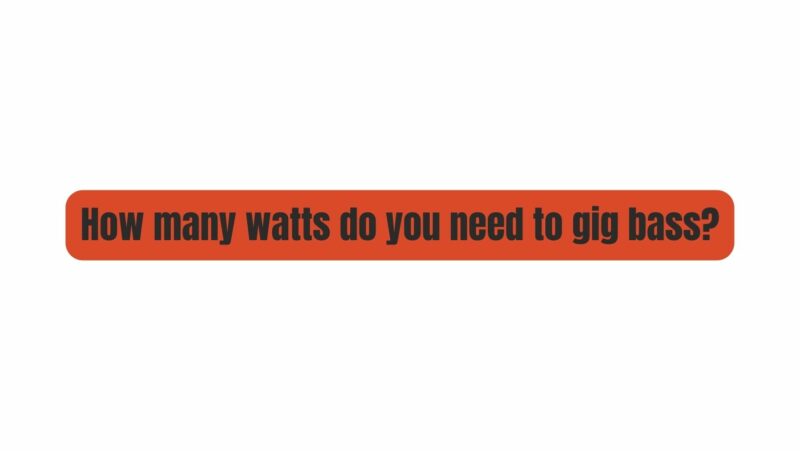As a bassist preparing for live performances, one of the most critical decisions you’ll make is selecting the right bass amplifier wattage. The choice of wattage can significantly impact the quality and impact of your bass guitar’s sound in a live setting. In this comprehensive guide, we’ll explore the factors that influence your wattage requirements, helping you find the perfect balance between power and tone for your gigs.
Understanding Wattage in Bass Amplifiers:
Before we dive into the specifics, it’s crucial to understand what wattage means in the context of bass amplifiers. Wattage refers to the power output of an amplifier, determining how loudly and clearly your bass guitar will be heard. A higher wattage typically results in more volume and headroom, allowing your bass lines to cut through the mix effectively.
1. Venue Size and Type:
The size and type of venue you’ll be playing in are among the most significant factors in determining your bass amp’s required wattage. Different venues demand varying levels of power. Here’s a breakdown:
a. Small Venues (Clubs, Bars, Cafes): – For intimate settings, 50 to 200 watts should be sufficient. – Consider a compact combo amp or a small bass head with an appropriate cabinet.
b. Medium-Sized Venues (Theaters, Halls): – In medium-sized venues, a power range of 200 to 500 watts generally works well. – Opt for a mid-sized combo amp or a bass head with a 2×10 or 4×10 cabinet.
c. Large Venues (Stadiums, Outdoor Festivals): – Gigging in large spaces requires 500 watts or more. – Invest in professional-grade bass amplifiers paired with powerful cabinets for maximum impact.
2. Music Genre and Playing Style:
The style of music you play and your playing technique play a significant role in determining your wattage requirements. Different genres and styles have unique demands:
a. Rock and Metal: – These genres often require higher wattage due to their loud and aggressive nature. – Consider a high-powered amp with a 4×10 or 8×10 cabinet to deliver the necessary punch.
b. Jazz and Blues: – For genres that prioritize clarity and subtlety, a lower wattage setup can work effectively. – Choose an amplifier that can reproduce the nuances of your playing accurately.
c. Funk and Fusion: – Versatility is key for these styles, so opt for a mid-wattage amp with a clean, well-balanced tone. – Focus on achieving a sound with excellent midrange presence.
3. Amplifier Type and Speaker Configuration:
The type of bass amplifier and the configuration of your speakers significantly impact your wattage requirements:
a. Solid-State vs. Tube Amps: – Solid-state amplifiers tend to be more efficient and provide more wattage per pound. – Tube amps may have lower wattage but offer a warmer, vintage tone loved by many bassists.
b. Speaker Efficiency: – Speaker efficiency, typically measured in decibels (dB), indicates how efficiently a speaker converts electrical power into sound. – Higher efficiency speakers require fewer watts to achieve the same volume level.
c. Multiple Cabinets: – Combining multiple speaker cabinets can distribute sound more evenly throughout the venue and increase overall volume. – Ensure your amplifier can handle the impedance load of multiple cabinets if you choose this route.
4. Sound Reinforcement Needs:
Consider whether you require additional sound reinforcement for specific elements of your performance:
a. Monitor Setup: – If you need on-stage monitoring, factor in the wattage for stage monitors. – A dedicated monitor mix will help you and your bandmates hear yourselves clearly during the performance.
b. Direct Input (DI): – Some venues may require a direct input connection to the PA system. – Check if your amplifier has a built-in DI output or use an external DI box for this purpose.
5. Budget Considerations:
While it’s essential to aim for the ideal wattage for your gigging needs, budget constraints are a reality for many musicians. Balance your desired wattage with your budget and consider factors such as amp portability and ease of transportation when making your decision.
Conclusion:
Selecting the right wattage for your bass amplifier is a critical decision that can significantly impact your live performances. By carefully considering factors such as venue size, music genre, amplifier type, speaker configuration, and budget, you can make an informed choice that ensures your bass lines are heard and felt by your audience. Remember that it’s not just about power; it’s about finding the perfect balance between wattage and tone to create an unforgettable musical experience at every gig. Whether you’re grooving in a small club or rocking a massive outdoor festival, the right wattage will help you deliver your best performance and keep the crowd moving to your bass lines.

